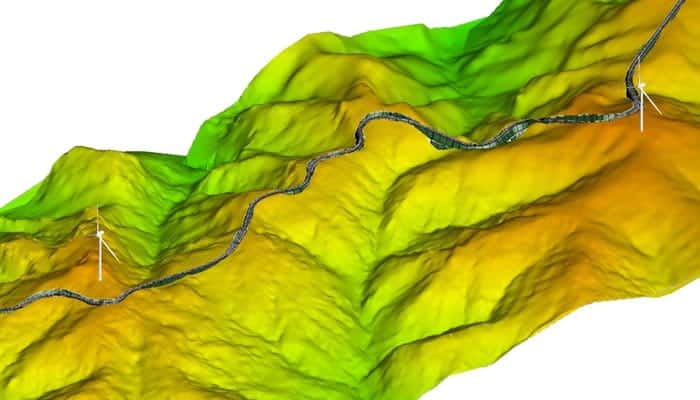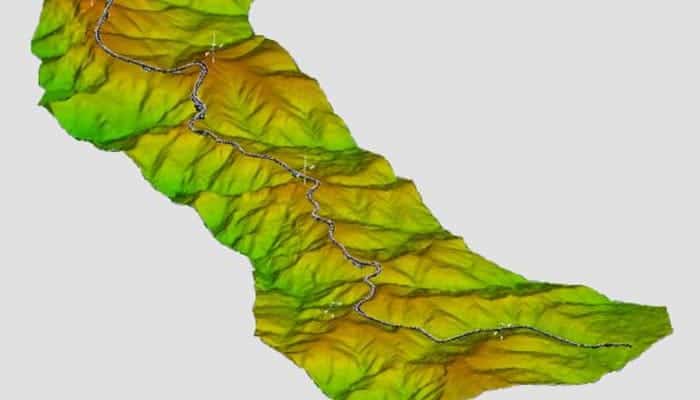Bringing a Floating Wind Farm to the Mountain
TBEA Xi’an Electric Design Co., Ltd.
Application of Digital Technology in Wind Farm Design
TBEA Xi’an Electric Design constructed a CNY 385 million, 50-megawatt wind farm in dense vegetation and steep terrain in Chengde, Hebei, China.
Key Project Details
- Project: Application of Digital Technology in Wind Farm Design
- Infrastructure Delivered: A 50-megawatt wind farm
- Owner: TBEA Sunoasis Co., Ltd.
- Lead Engineers: TBEA Xi’an Electric Design Co., Ltd.
- Completion Date: December 2021
By creating 3D models of the site, TBEA Xi’an Electric Design Company determined how to bring wind energy to the seemingly undevelopable area.
When complete, the wind farm will reduce standard coal use by 363 million tons per year, as well as carbon dioxide emissions by 1 billion tons.
Designing a Large Wind Farm over Difficult Terrain
To lower carbon emissions from generated power, the Chinese energy transition plan has a five-year plan to reduce its fossil fuel energy mix by 4%. To support that plan, TBEA Xi’an Electric Design Co., Ltd. initiated the Longhua Guangsheng Aobao Wind Farm project. They were tasked with planning floating wind turbines in a ring formation, with a total height of 108 meters. They also had to plan out the roadways running through the wind farm and to a nearby substation. The wind farm would need to have a capacity of 50 megawatts and an output of 117 million kilowatt hours. The team had to create an accurate design so that construction could be completed in only 15 months. They also needed to ensure that they kept road construction costs at a minimum, in addition to keeping the design as efficient as possible.
Finding a Better Way to Conduct Site Surveys
To take on these issues, TBEA Xi’an Electric Design realized that traditional methods of conducting topographic surveys and creating terrain models would not be possible. So, they began looking for software that would allow them to not only create 3D models of the site, but also model the planned roadways and substation. The team also wanted to ensure that their design was as accurate and efficient as possible, providing simulations that would allow the multidiscipline team to work together in a highly visual environment. Therefore, they decided to implement collaborative 3D modeling software.
Using 3D Modeling Software to Design All Site Aspects
After considering their options, TBEA Xi’an Electric Design chose Bentley applications for this complex project. Using data taken from UAV-captured images, the team created a 3D reality model with ContextCapture to intuitively reflect the landscape, allowing them to optimize the layout of the wind farm. To coordinate materials transportation, they used OpenRoads to carry out road design, which allowed them to consider the surrounding vegetation conditions. OpenBuildings Designer helped them with the wind turbine foundations, as they are similar in structure to high-rise buildings. The application also allowed the team to conduct the necessary calculations and ensure that the design met geographical and wind conditions. With SYNCHRO 4D, TBEA Xi’an Electric Design performed simulations of hoisting the wind turbines, determining the optimal platform size best suited for the local environment.
Saving Time and Cost while Providing Clean Energy
TBEA Xi’an Electric Design’s use of ContextCapture cut the surveying time in half, providing a model that was accurate within 5 centimeters. By using Bentley applications, the team detected and corrected clashes in the underground facilities, eliminating more than 100 instances of rework. With the help of 3D technology, the site design was improved to save CNY 3.8 million in materials and earthwork volume costs. SYNCHRO 4D’s simulations reduced the hoisting platform by a third, saving material costs and positively impacting the local environment. When complete, the wind farm will provide a clean power supply to 150,000 people and produce 200 jobs. Bentley applications were critical in helping TBEA Xi’an Electric Design develop a wind farm that is expected to reduce the use of 363 million tons of standard coal per year and lower carbon dioxide emissions by 1 billion tons, as well as the emission of other harmful gases.
The Impact
Contributing to sustainable and resilient infrastructure, and to progress on the U.N. Sustainable Development Goals:
Provide clean, renewable energy to 150,000 people and lower carbon emissions by 1 billion tons.
Provide 200 jobs to the local economy.
“Digital 3D design lets us advance our design method, control costs in the different design stages, improve the design efficiency, and show that what you see is what you get. A whole lifecycle digital twin of our project is our future development goal.”
Qinwen Guo, Chief Executive Officer, TBEA Xi’an Electric Design Co., Ltd.


